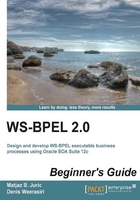
Developing our first BPEL process
In this section, we will develop our first BPEL process. We will start with a simple BPEL process to get things rolling. Earlier in this chapter, we explained that BPEL is usually used to orchestrate services. This is true. However, in our first BPEL process, we will not be able to orchestrate services, as we do not have any. Rather, we will create a very simple BPEL process, which will return the number of books in stock.
Before we start, let's have a brief look at the artifacts that need to be created. Each BPEL process is part of the SOA composite. SOA composite shows all components, relations between components, service interfaces, and links to external services (external references). In addition to the BPEL processes, an SOA composite can include human tasks, business rules, mediators, adapters, and other components. Our first step will be the creation of an SOA composite.
Each BPEL process also consists of several artifacts. The most important is the BPEL code, which uses XML representation. Each BPEL process also has a WSDL interface, through which it can be invoked. The third artifact is XML Schema Definition (XSD) used by BPEL and WSDL. Our second step will be the creation of BPEL with the corresponding XSD and WSDL.
We will proceed in two steps. First, we will create the SOA composite application. Then, we will add the BPEL process with the corresponding XSD and WSDL (first, we will create the XML Schema, then WSDL, and then we will implement the BPEL process).